人体解剖学(英文版)课件
《人体解剖学》PPT课件
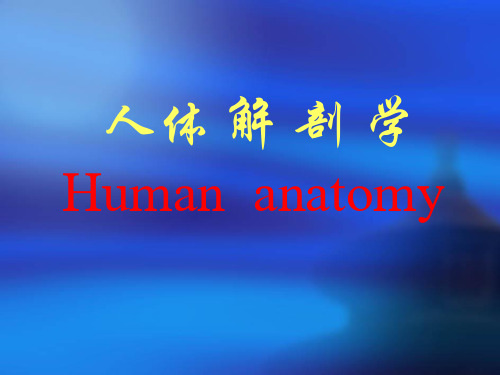
(三)轴和面
1、轴: 1)垂直轴-上、下方向走行; 2)矢状轴-前、后方向走行; 3)冠(额)状轴-左、右方向走行。
2、面: 1)矢状面(纵切面)-将人体分成左、右两半, (居于正中,将身体分为左右相等两半称正中矢状面)
2)冠状面(额状面)-将人体分成前、后两半; 3)水平面(横切面)-将人体分成上、下两半。 器官:纵切面-与长轴平行 横切面-与长轴垂直
(一)缝(suture):相邻颅骨之间借少量结缔组织相 连,如矢状缝,冠状缝等。
(二)韧带连结(syndesmosis):两骨之间借韧带或 结缔组织相连,富于弹性,如黄韧带。
二、软骨和骨性连结:两骨借软骨或骨相连。 (一)透明软骨结合(synchondrosis):借透明软骨 相连,可骨化成骨性结合,如第一 肋和胸骨柄之间的连接。 (二)纤维软骨结合(symphsis):借纤维软骨相连, 终生不骨化,如椎间盘和耻骨联合。 (三)骨性结合(synostosis):借骨组织相连,一般由 结缔组织纤维或透明软骨骨化而成,如 各骶椎之间的骨性结合。
人体 解 剖 学 Human anatomy
绪论
一、人体解剖学(human anatomy):研究正常人体各器 官形态、结构、位置、毗邻关系及其发生发展规律 的科学,属于生物学中形态学的范畴。 目的:使学生理解和掌握人体各器官系统的形态结构 特点及其相互关系,为学习其他基础医学和临
床医学课程奠定必要的形态学基础。
(一) 细胞+间质 组织 器官 系统 人体
(二)人体九大系统:
1. 运动系统; 2、消化系统; 3、呼吸系统; 4、泌尿系 统; 5、生殖系统; 6、脉管系统; 7、内分泌系统; 8、感觉器; 9、神经系统。 (三)分部:
1、头部:颅、面。 2、颈部:颈、项。 3、躯干部:胸部、腹部、盆部。 4、四肢:左、右上肢:肩、臂、前臂、手;
英文人体系统解剖PPT课件
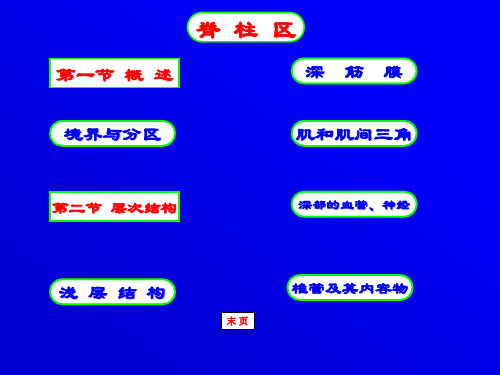
自胸锁乳突肌后缘中、上1/3交界处斜向外下至斜方肌。
总目录
枕动脉
返回
椎动脉 肩胛背动脉
返回
返回
胸背神经
返回
返回
椎管及其内容物
一、椎管: 内 容
二、脊髓: 内 容
内 容 三、脊髓的被膜与脊膜腔: 内 容 四、脊神经根: 内 容 五、脊髓的血管:
总目录
THANK
YOU
SUCCESS
2019/4/15
图 片下 页
返回
肌和肌间三角
二、肌间三角: (一)听诊三角: 居斜方肌下方和肩胛骨内 侧缘下份之间的肌间隙。
内上界:斜方肌外下缘;
外侧界:肩胛骨内侧缘; 下界:背阔肌上缘。 三角深面为第6肋间隙, 胸壁薄,听诊肺呼吸音。
下 页
听诊三角
(二)枕下三角:
肌和肌间三角
项区上部深面,枕下肌围成。 内上界:头后大直肌;
下 页
浅
(二)胸背区、腰区:
层
结
构
皮神经来自胸、腰神经后支的分支,于棘突两侧浅出,分布 至胸背区、腰区的皮肤。 T12后支分支—臀部; L1-3后支外侧支—臀上皮神经—竖脊肌外侧缘穿出胸腰筋膜, 下越髂嵴—臀区上部皮肤。 (三)骶尾区:
S1-3后支分支—臀中皮神经。
总目录 图 片
返 回
枕大神经
总目录
深部的血管、神经
一、动脉: 1.枕动脉(occippital 2.肩胛背动脉(dorsal 3.椎动脉(vertebral artery): scpular artery):
图 片
图 ): 片 artery 图 片
二、静脉:
脊柱区的深静脉与动脉伴行。项区静脉汇入椎静脉、颈内静 脉或锁骨下静脉。胸背区的静脉大部分汇入奇静脉,下部分 汇入锁骨下静脉和腋静脉。腰区的静脉汇入下腔静脉。骶尾 区的静脉汇入髂内静脉。脊柱区深静脉在脊柱周围形成椎外 静脉丛,并与椎管内、颅内等处的静脉相交通。
人体解剖学英文课件body structure1
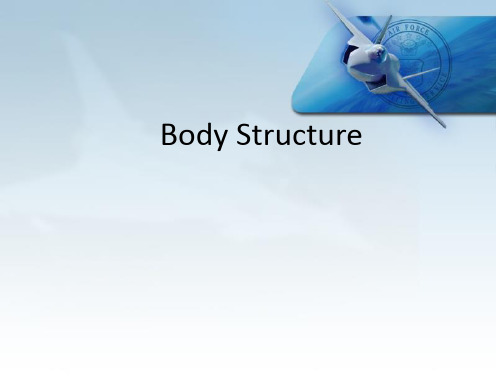
FIGURE Directional terms. (Reprinted with permission from Cohen BJ, Wood DL. Memmler’s The Human Body in Health and Disease. 9th Ed. Philadelphia: Lippincott Williams & Wilkins, 2000.)
directions in which the body can be cut. A frontal plane, also called a coronal plane, is made at right angles to the midline and divides the body into anterior and posterior parts. A sagittal (SAJ-i-tal) plane passes from front to back and divides the body into right and left portions. If the plane passes through the midline, it is a midsagittal or medial plane. A transverse plane passes horizontally, dividing the body into superior and inferior parts.
6. Describe the main body positions used in medical practice. 7. Define basic terms describing body structure. 8. Recognize and use roots pertaining to body regions. 9. Recognize and use prefixes pertaining to position and
乳腺解剖课件(中英文版)
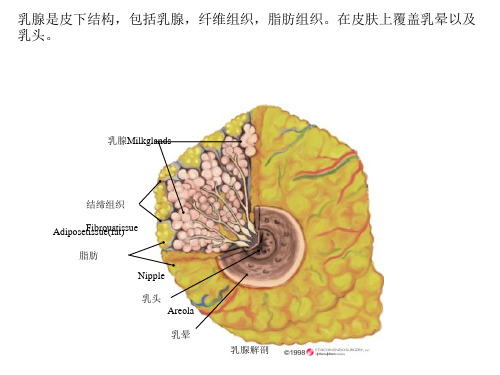
Pectoralis major fascia
胸大肌筋膜
Pectoralis major al fascia (deep layer) 深层浅筋膜
Superficial fascia (superficial layer)
Central axillary nodes
parenchyma will drain to the lymphatic
Brachial
system associated with the internal
(lateral axillary)
nodes
thoracic vessels.
Subscapular
Over time, due to factors scientist poorly understand, the cells in the breast lobules and ducts may undergo changes. Some of these changes increase a woman’s risk of developing breast cancer while other changes are cancerous. To understand these changes let’s look at a duct in cross section. This view is what it would be seen if a piece of breast tissue were removed from the breast and then examined under a microscope. 随着时间推移, 由于某些无法解释的原因, 乳腺小叶和乳管会发生变化. 有些 变化会增加妇女罹患乳腺癌的风险. 而有些变化本身就是癌变. 要了解这些 变化, 让我们来看一看乳腺的横截面.
人体解剖学Humananatomy-46页PPT资料
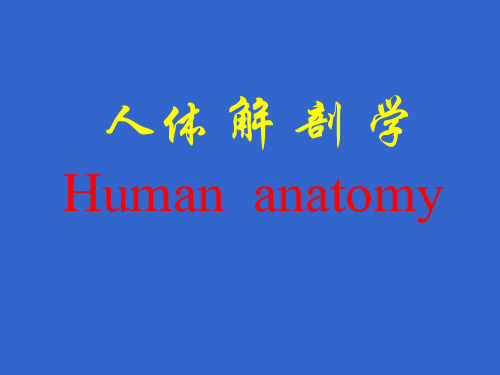
第五篇 感觉器 概述: 一、感觉器(sensory organs):机体感觉刺激的
装置,是感觉器和附属结构的总称。 感受器:是机体接受内外环境各种刺激的结构。 二、据部位和接受刺激的来源: (一)外感受器:分布于皮肤、鼻腔和口腔粘
膜、视器、听器。 (二)内感受器:分布于内脏和心血管等处。 (三)本体感受器:分布在肌肉、肌腱、关节、
1)眼房:是位于角膜、晶状体、睫状小带和睫 状体之间的空隙,被虹膜分为眼前房和眼后房, 两房借瞳孔相通。
2)房水的产生和循环途径:
睫状体产生 眼后房 瞳孔 眼前房 虹 膜角膜角 虹膜角膜角隙 巩膜静脉窦 睫前静脉 眼静脉
房水功能:折光、营养角膜和晶状体、维持眼内 压。
临床:房水过多或循环受阻,眼内压增高,引起 青光眼。
2、晶状体:双凸透镜状,无色透明。 视近物时:睫状肌收缩 睫状小带松弛 晶状
体变厚 视远物时:睫状肌舒张 睫状小带紧张 晶状
体变薄 晶状体异常:近视眼、老花眼、白内障。 3、玻璃体:无色透明胶状物质,有折光和对视网
膜支撑作用。
第二节 眼副器
一、眼睑:ຫໍສະໝຸດ 1、主要结构:上睑、下睑、睑裂、内眦、外眦
2、皮肤、皮下组织、肌层、睑板、结膜。
韧带和内耳平衡器等处。
第一章 视器 组成 眼球
眼副器:眼睑、结膜、泪器、眼球外肌、 眶筋膜及眶脂体。 第一节 眼球 前极:前面的正中点 后极:后面的正中点
一、眼球的外形 赤道(中纬线):两极间中点 沿眼球表面所做的环行线
眼轴:前极至后极的矢状轴 视轴:瞳孔中央至视网膜中央 凹
二、眼球的构造: (一)、眼球壁:
(二)膜迷路: 1、椭圆囊:椭圆囊斑 感受静止和直线变速运 动时位置变化的刺激。 球 囊:球囊斑 2、膜半规管:壶腹嵴,感受旋转变速运动时位 置变化的刺激。 上壁:前庭襞
解剖英文
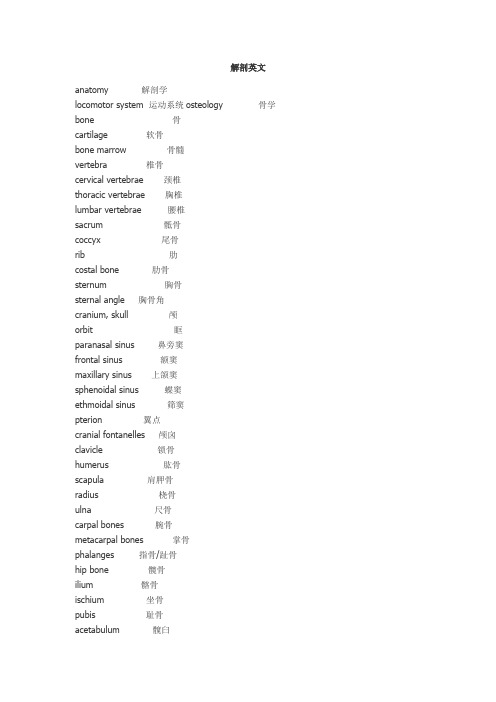
解剖英文anatomy 解剖学locomotor system 运动系统osteology 骨学bone 骨cartilage 软骨bone marrow 骨髓vertebra 椎骨cervical vertebrae 颈椎thoracic vertebrae 胸椎lumbar vertebrae腰椎sacrum 骶骨coccyx 尾骨rib 肋costal bone 肋骨sternum 胸骨sternal angle 胸骨角cranium, skull 颅orbit 眶paranasal sinus 鼻旁窦frontal sinus 额窦maxillary sinus 上颌窦sphenoidal sinus 蝶窦ethmoidal sinus 筛窦pterion 翼点cranial fontanelles 颅囟clavicle 锁骨humerus 肱骨scapula 肩胛骨radius 桡骨ulna 尺骨carpal bones 腕骨metacarpal bones掌骨phalanges 指骨/趾骨hip bone 髋骨ilium 髂骨ischium 坐骨pubis 耻骨acetabulum 髋臼femur 股骨patella 髌骨tibia 胫骨fibula 腓骨tarsal bones 跗骨metatarsal bones 跖骨arthrology 关节学fibrous joint 纤维连结cartilaginous joint 软骨连结synosteosis 骨性结合joint, articulation 关节vertebral column 脊柱intervertebral disc 椎间盘thoracic cage 胸廓temporomandibular joint颞下颌关节shoulder joint 肩关节elbow joint 肘关节radiocarpal joint/wrist joint桡腕关节pubic symphysis 耻骨联合pelvis 骨盆terminal line 界线sarotuberous ligament骶结节韧带sarospinous ligament骶棘韧带greater sciatic foramen坐骨大孔hip joint 髋关节knee joint 膝关节ankle joint 踝关节transverse tarsal joint跗横关节meniscus 半月板mycology 肌学muscle 肌肉tendon 肌腱aponeurosis 腱膜fascia 筋膜trapezius m. 斜方肌latissimus dorsi m. 背阔肌erector spinae m. 竖脊肌sternocleidomastoid m.胸锁乳突肌pectoralis major m. 胸大肌serratus anterior m. 前锯肌intercostal m. 肋间肌diaphragm 膈obliquus externus abdominis m. 腹外斜肌inguinal ligament 腹股沟韧带sheath of rectus abdominis腹直肌鞘linea alba 腹白线inguinal canal 腹股沟管inguinal triangle 腹股沟三角deltoid m. 三角肌biceps brachii m. 肱二头肌triceps brachii m. 肱三头肌gluteus maximus m. 臀大肌sartorius m. 缝匠肌quadriceps femoris m.股四头肌adductor magnus m. 大收肌triceps surae m. 小腿三头肌splanchnology 内脏学alimentary system 消化系统digestive tube/digestive tract消化管oral cavity 口腔palate 腭tongue 舌cheek 颊tooth 牙tonsil 扁桃体salivary glands 唾液腺sublingual gland 舌下腺parotid gland 腮腺submandibular gland 下颌下腺pharynx 咽esophagus 食管stomach, gaster 胃cardia 贲门pylorus 幽门small intestine 小肠duodenum 十二指肠jejunum 空肠ileum 回肠caecum 盲肠vermiform appendix 阑尾colon 结肠sigmoid colon 乙状结肠rectum 直肠anal canal 肛管anus 肛门liver, hepar 肝porta hepatis 肝门gall bladder 胆囊pancreas 胰respiratory system 呼吸系统nose 鼻nasal cavity 鼻腔larynx 喉trachea 气管bronchus 支气管lung 肺pleura 胸膜pleural cavity 胸膜腔pleural recesses 胸膜隐窝costodiaphragmatic recess肋膈隐窝mediastinum 纵隔urinary system 泌尿系统kidney 肾renal hilum 肾门renal pedicle 肾蒂ureter 输尿管urinary bladder 膀胱urethra 尿道reproductive system生殖系统testis 睾丸epididymis 附睾ductus deferens 输精管ejaculatory duct 射精管spermatic cord 精索prostate/prostate gland前列腺seminal vesicle 精囊bulbourethral gland 尿道球腺scrotum 阴囊penis 阴茎ovary 卵巢uterine tube 输卵管uterus 子宫vagina 阴道mamma, breast 乳房perineum 会阴pelvic diaphragm 盆膈urogenital diaphragm尿生殖膈peritoneum 腹膜greater omentum 大网膜omental burse 网膜囊mesentery 肠系膜subphrenic space 膈下间隙rectovesical ponch直肠膀胱陷凹rectouterine pouch直肠子宫陷凹angiology 脉管学cardiovascular system心血管系统lymphatic syatem 淋巴系统heart 心cardiac atrium 心房cardiac ventricle 心室tricuspid valve 三尖瓣mitral valve 二尖瓣conus arteriosus 动脉圆锥pulmonary orifice 肺动脉口aortic sinus 主动脉窦interatrial septum 房间隔interventricular septum 室间隔sinuatrial node 窦房结atrioventricular node 房室结atrioventricular bundle房室束coronary artery 冠状动脉pericardium 心包pulmonary trunk 肺动脉干arterial ligament 动脉韧带common carotid a.颈总动脉carotid glomus 颈动脉小球internal carotid a. 颈内动脉facial a. 面动脉superficial temporal a.颞浅动脉subclavian a. 锁骨下动脉axillary a. 腋动脉brachial a. 肱动脉ulnar a. 尺动脉radial a. 桡动脉superficial palmar arch 掌浅弓thoracic aorta 胸主动脉abdominal aorta 腹主动脉coeliac trunk 腹腔干left gastric a. 胃左动脉common hepatic a. 肝总动脉splenic a. 脾动脉right gastroepiploic a. 胃网膜右动脉superior mesenteric a.肠系膜上动脉common iliac a. 髂总动脉external iliac a. 髂外动脉popliteal a. 腘动脉posterior tibial a. 胫后动脉peroneal a. 腓动脉dorsal artery of foot 足背动脉uterine a. 子宫动脉superior vena cava 上腔静脉brachiocephalic vein头臂静脉internal jugular v. 颈内静脉cephalic v. 头静脉basilic v. 贵要静脉median cubital v. 肘正中静脉azygos v. 奇静脉great saphenous v. 大隐静脉portal v. 门静脉paraumbilical v. 附脐静脉thoracic duct 胸导管superficial inguinal lymph nodes 腹股沟浅淋巴结spleen 脾thymus 胸腺sensory organs 感觉器visual organs 视器eye 眼cornea 角膜sclera 巩膜iris 虹膜pupil 瞳孔ciliary body 睫状体choroid 脉络膜retina 视网膜optic disc 视神经盘macula lutea 黄斑aqueous humor 房水lens 晶状体vitreous body 玻璃体conjunctiva 结膜lacrimal apparatus 泪器ear 耳tympanic membrane 鼓膜tympanic cavity 鼓室auditory tube 咽鼓管vestibule 前庭cochlea 耳蜗semicircular canal 半规管peripheral nervous system周围神经系统spinal nerve 脊神经spinal ganglia 脊神经节cervical plexus 颈丛phrenic n. 膈神经brachial plexus 臂丛median n. 正中神经musculocutaneous n. 肌皮神经intercostal n. 肋间神经lumbar plexus 腰丛obturator n. 闭孔神经sacral plexus 骶丛sciatic n. 坐骨神经tibial n. 胫神经common peroneal n. 腓总神经cranial n. 脑神经olfactory n. 嗅神经optic n. 视神经oculomotor n. 动眼神经trochlear n. 滑车神经trigeminal n. 三叉神经ophthalmic n. 眼神经maxillary n. 上颌神经mandibular n. 下颌神经abducent n. 展神经facial n. 面神经vestibulocochlear n.前庭蜗神经glossopharyngeal n. 舌咽神经vagus n. 迷走神经accessory n. 副神经hypoglossal n. 舌下神经chorda tympani 鼓索autonomic nervous system自主神经系统sympathetic nerve交感神经parasympathetic nerve副交感神经central nervous system中枢神经系统spinal cord脊髓gray matter灰质cortex 皮质nucleus 神经核white matter 白质medulla 髓质fasciculus 纤维束ganglion 神经节reticular formation 网状结构spinal cord脊髓anterior horn前角posterior funiculus 后索anterior white commissure白质前连合fasciculus gracilis 薄束fasciculus cuneatus 楔束spinothalamic tract脊髓丘脑束corticospinal tract 皮质脊髓束corticonuclear tract 皮质核束brain, encephalon 脑brain stem脑干medulla oblongata延髓pyramid锥体pyramidal decussation锥体交叉pons脑桥midbrain, mesencephalon中脑red nucleus 红核substantia nigra 黑质cerebellum小脑diencephalon间脑thalamus丘脑hypothalamus 下丘脑optic chiasma 视交叉medial geniculate body内侧膝状体telencephalon端脑lateral ventricle侧脑室choroid plexus脉络丛internal capsule 内囊corpus callosum 胼胝体corpus striatum 纹状体cerebral cortex 大脑皮质hippocampal formation海马结构limbic system 边缘系统extrapyramidal system锥体外系cerebral dura mater 硬脑膜cavernous sinus海绵窦epidural space 硬膜外隙subarachnoid space蛛网膜下隙spinal pia mater 软脊膜cerebrospinal fluid 脑脊液endocrine glands 内分泌腺thyroid gland 甲状腺parathyroid gland甲状旁腺suprarenal gland肾上腺hypophysis垂体pineal corpus松果体。
人体解剖学human-anatomy(绪论及运动系统(骨)综合)PPT课件
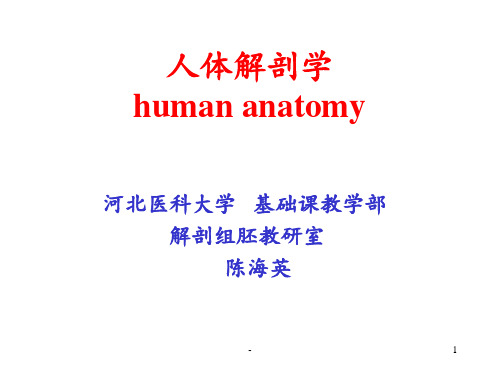
-
54
颅前窝Anterior cranial fossa
• 结构:
– 鸡冠 – 筛板 – 筛孔
-
55
颅中窝Meddle cranial fossa
• 结构
– 垂体窝 – 视神经管 – 眶上裂 – 圆孔 – 卵圆孔 – 棘孔
-
56
颅后窝Posterior cranial fossa
-
12
3)骨髓: 红骨髓: 胎儿及幼儿骨内;成人骨 骨松质腔隙内,具有造血功能。 黄骨髓: >6岁后长骨骨髓腔,含有 大量的脂肪组织。具有潜在造血功 能。
-
13
4、化学成分和物理性质 Chemical composition and physical properties
• Organic material有机质: 主要是骨胶原纤维和粘多糖蛋白。构成支架,赋予 骨的弹性和韧性。
髂骨:髋臼、髂嵴、髂前上棘、髂前下棘,、髂结节、髂后上 棘、髂后下棘、坐骨大切迹、髂窝、弓状线、耳状面。
-
37
-
38
• 坐骨 坐骨棘、 坐骨小切迹、 坐骨结节。
• 耻骨 耻骨上支: 耻骨梳、耻骨结节、 耻
骨联合面。
耻骨下支: 闭孔。
-
39
股骨Femur
• 人体最粗大的骨 • 上端:股骨头,股骨头凹,
• Inorganic salts无机质: 主要是碱性磷酸钙、碳酸钙和氯化钙。赋予骨硬度 和脆性
Children Adult Old
Organic material 1 3(1/3) 1
Inorganic salts 1 7(2/3) 4
-
《人体解剖学》PPT课件
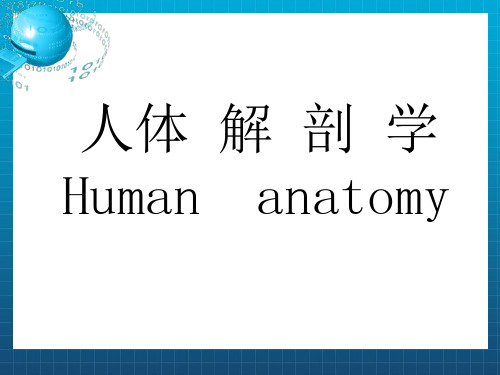
左、右下肢:臀、大腿、小腿、
四、人体解剖学的基本术语 (一)解剖学姿势:人体直立,面向前方,两眼平视正 前方,两上肢下垂于躯干两侧,手掌向前,两足并立,足 尖向前。
(二)方位术语:
1、上(颅侧): 近头者 下(尾侧): 近
足者
2、前(腹侧): 近腹者
后(背侧):
近背者
3、内侧:近正中面者
外侧:远正中面者。
二、骨连结(articulation)
概念:骨连结(articulation):骨与骨之
间借结缔组织纤维、软骨或骨组织相连,称为骨
连接或关节(jiont)。
纤维
连结
直接连结 软骨软骨
分类
骨性结合
间接连结 滑膜关节
连,如矢状缝,冠状缝等。 2 、韧带连结(syndesmosis):两骨之间借韧带或
纤维结缔组织构成 的膜。
(1)骨外膜
外层:致密,有许多胶厚纤维束
穿
入骨质,
使之固定于骨面。
内层:疏松,有成骨
细胞和破骨细胞
(2)骨内膜:衬于骨髓腔内面和骨松质腔隙内,含
有成骨细胞和破骨细胞。
3 、骨髓:存在于长骨的骨髓腔和骨松质的间隙 内,
分为红骨髓和黄骨髓。
4 、血管、淋巴管和神经。
(三)骨的化学成分和物理性质 1 、有机物:占成人骨1/3,使骨具有弹性和韧性;煅 烧骨,质脆易碎。 2 、无机物:占成人骨2/3,使骨增加硬度;脱钙骨, 柔软有弹性。 3 、幼 儿:有机物多,青枝折 老年人:无机物多,粉碎折。
1)纤维膜(fibrous membrane):为外层,由致 密纤维结缔组织构成。
人体 解 剖 学 Human anatomy
绪
论
一、人体解剖学(human anatomy):研究正常人体各器官形态、结构、位置、毗邻关系及其发生发展 规律的科学,属于生物学中形态学的范畴。
解剖学(英文版)全套PPT课件
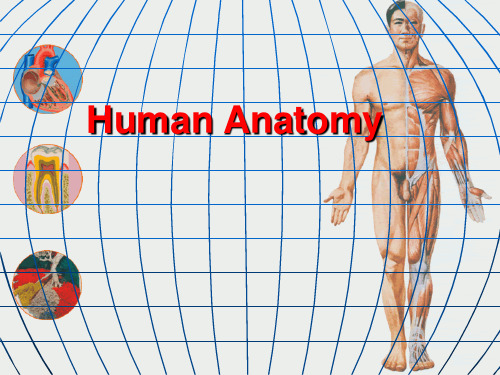
No. 1
1. Introduction of Human Anatomy 2. Introduction of Osteology (Bony System)
Introduction of Human Anatomy
Definition: Human anatomy is the science which deals with the gross morphology and spacial interrelations of the structures of the body. The term “anatomy” is derived from the Greek words meaning “apart” and “to cut.” Significance: For medical students, human anatomy is the basic course of preclinical and clinical curriculum. Classification: Owing to different methods and purposes of study, human anatomy is classified into systematic anatomy, and regional anatomy.
Regional anatomy and systematic anatomy: Gross anatomy can be studied by regions, such as the head, neck, thorax, abdomen, pelvis, or limbs. This approach, referred to as regional anatomy, is often used in dissection, in which all structures in a region are studied simultaneously. However, for our purposes the study of anatomy by organ systems that perform common functions (systemic anatomy) is most beneficial and this book uses that approach.
《人体解剖学》ppt课件共102页

四. 人体的分部与器官系统
人体分为10个 局部
四. 人体的分部与器官系统
细胞 cell
组织 器官 tissue organ
系统 system
人体 human body
运 动 系 统
人
体
的
各
系
心 血
统
管 系
统
消
呼泌
化
吸尿
系
系系
统
统统
淋
神
巴
经
系
系
统
统
男女 生生 殖殖 系系 统统
感
内
觉
分
器
泌
系
系
统
统
运动系统
组成
骨------支架 骨连结------枢纽
骨骼skeleton
肌------动力
功能
在神经系统的支配下完成各种运动
对身体起着支持体重,保护内脏,赋予人体 基本形态的作用。
一.骨学总论
• 坚硬有弹性的活器官 • 丰富血管、神经、淋巴管 • 新陈代谢、生长发育 • 损伤后可修复和重建 • 运动和锻炼可促进骨良好发育 • 长期废用可萎缩 • 钙,磷的储存库
(1)胸椎(thoracic vertebra): • 有肋凹,上肋凹,下肋凹,横突肋凹 • 关节突关节面呈冠状位 • 棘突长,斜向后下方,呈叠瓦状排列
(一)椎骨(vertebra)
2.各部椎骨的特点
(2)颈椎(cervical vertebra) • 体小孔大,近似三角形 • 上下关节突关节面近水平面 • 有横突孔 • 2~6颈椎棘突末端分叉 • 颈动脉结节 • 钩椎关节(Luschka关节) • 寰椎、枢椎、隆椎
我国人体解剖学的发展历程
解剖英语
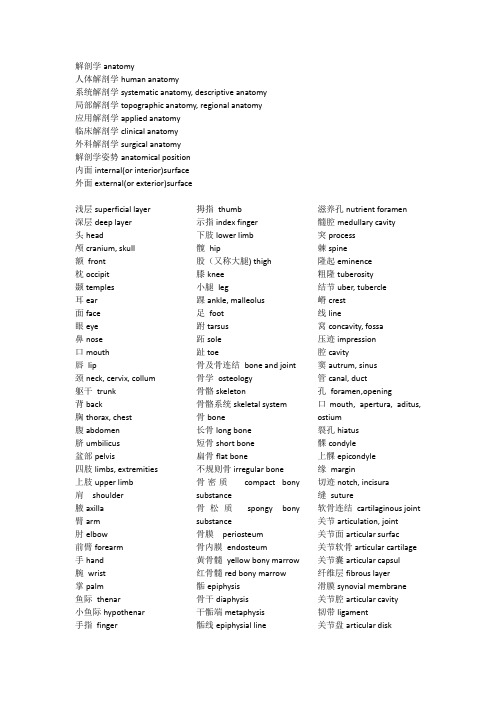
解剖学anatomy人体解剖学human anatomy系统解剖学systematic anatomy, descriptive anatomy 局部解剖学topographic anatomy, regional anatomy 应用解剖学applied anatomy临床解剖学clinical anatomy外科解剖学surgical anatomy解剖学姿势anatomical position内面internal(or interior)surface外面external(or exterior)surface浅层superficial layer 深层deep layer头head颅cranium, skull额front枕occipit颞temples耳ear面face眼eye鼻nose口mouth唇lip颈neck, cervix, collum 躯干trunk背back胸thorax, chest腹abdomen脐umbilicus盆部pelvis四肢limbs, extremities 上肢upper limb肩shoulder腋axilla臂arm肘elbow前臂forearm手hand腕wrist掌palm鱼际thenar小鱼际hypothenar手指finger 拇指thumb示指index finger下肢lower limb髋hip股(又称大腿) thigh膝knee小腿leg踝ankle, malleolus足foot跗tarsus跖sole趾toe骨及骨连结bone and joint骨学osteology骨骼skeleton骨骼系统skeletal system骨bone长骨long bone短骨short bone扁骨flat bone不规则骨irregular bone骨密质compact bonysubstance骨松质spongy bonysubstance骨膜periosteum骨内膜endosteum黄骨髓yellow bony marrow红骨髓red bony marrow骺epiphysis骨干diaphysis干骺端metaphysis骺线epiphysial line滋养孔nutrient foramen髓腔medullary cavity突process棘spine隆起eminence粗隆tuberosity结节uber, tubercle嵴crest线line窝concavity, fossa压迹impression腔cavity窦autrum, sinus管canal, duct孔foramen,opening口mouth, apertura, aditus,ostium裂孔hiatus髁condyle上髁epicondyle缘margin切迹notch, incisura缝suture软骨连结cartilaginous joint关节articulation, joint关节面articular surfac关节软骨articular cartilage关节囊articular capsul纤维层fibrous layer滑膜synovial membrane关节腔articular cavity韧带ligament关节盘articular disk关节唇articular labrum滑膜关节synovial joint平面关节plane joint屈flexion伸extension收adduction展abduction旋转rotation环转circumduction旋前pronation旋后supination外翻eversion内翻inversion背屈dorsiflexion跖屈plantarflexion椎骨vertebrae脊柱vertebral column椎管vertebral canal椎体vertebral body颈椎cervical vertebrae横突孔transverse foramen 寰椎atlas侧块lateral mass枢椎axis齿突dens胸椎thoracic vertebrae腰椎lumbar vertebrae骶骨sacrum, sacral bone尾骨coccyx椎间盘intervertebral disc纤维环anulus fibrosus髓核pulpiform nucleus黄韧带ligaments flava肋ribs, costae肋软骨costal cartilage肋沟costal groove肋弓costal arch胸骨sternum胸骨柄sternal manubrium 胸骨体sternal body剑突xiphoid process胸骨角sternal angle胸廓thoracic cage肋椎关节costovertebral joints胸肋关节sternocostal joints枕骨occipital bone枕骨大孔foramen magnum蝶骨sphenoid bone视神经管optic canal破裂孔foramen lacerum圆孔foramen rotundum卵圆孔foramen ovale棘孔foramen spinosum眶上裂superior orbitalfissure大翼greater wings翼突pterygoid process颞骨temporal bone乳突mastoid process面神经管facial canal肌咽鼓管musculo-tubalcanal内耳门internal acoustic port茎突styloid process下颌窝mandibular fossa顶骨parietal bone额骨frontal bone筛骨ethmoid bone下鼻甲inferior nasal concha泪骨lacrimal bone鼻骨nasal bone犁骨vomer上颌骨maxilla腭骨palatine bone颧骨zygomatic bone下颌骨mandible舌骨hyoid bone颧弓zygomatic arch眶orbit鼻腔nasal cavity冠状缝coronary suture矢状缝sagital suture人字缝lambdoid suture肩胛骨scapula肩峰acromion关节盂glenoid cavity喙突coracoid process锁骨clavicle肱骨humerus桡骨radius尺骨ulna鹰嘴olecranon腕骨carpal bones, carpus舟骨scaphoid bone三角骨triquetral bone豌豆骨pisiform bone大多角骨trapezium bone小多角骨trapezoid bone头状骨capitate bone钩骨hamate bone掌骨metacarpal bones指骨phalanges of fingers胸锁关sternoclavicular joint肩关节shoulder joint盂唇glenoid labrum肘关节elbow joint腕关节wrist joint髋骨hip bone髋臼acetabulum闭孔obturater foramen髂骨ilium髂嵴iliac crest坐骨ischium耻骨pubis骨盆pelvis股骨femur大转子greater trochanter髌骨patella胫骨tibia内踝medial malleolus腓骨fibula外踝lateral malleolus跗骨tarsal bone, tarsus距骨talus跟骨calcaneus足舟骨navicular bone骰骨cuboid bone趾骨phalanges of toes髋关节hip joint膝关节knee joint半月板meniscus交叉韧带cruciate ligaments 踝关节ankle joint(二)肌肉muscles肌学myology肌肉系统muscular system 肌muscle骨骼肌skeletal muscle腱膜aponeurosis起点origin止点insertion筋膜fascia浅筋膜superficial fascia深筋膜deep fascia滑膜囊synovial bursa腱鞘tendinous sheath膈diaphragm中心腱central tendon腹直肌rectus abdominis 白线linea alba腹外斜肌obliquus externus abdominis腰大肌psoas major髂腰肌iliopsoas面肌facial muscles咬肌masseter颞肌temporalis三角肌deltoid大圆肌teres major小圆肌teres minor肱二头肌biceps brachii肱三头肌triceps brachii肱桡肌brachioradialis臀大肌gluteus maximus梨状肌piriformis股四头肌quadriceps femoris髌韧带patellar ligament缝匠肌sartorius股二头肌biceps femoris半腱肌semitendinosus半膜肌semimembranosus 腓骨长肌peroneus longus 腓骨短肌peroneus brevis 胫骨前肌tibialis anterior 小腿三头肌triceps surae腓肠肌gastrocnemius比目鱼肌soleus跟腱tendo calcaneus内脏学splanchnology消化系统digestive system内脏学splanchnology内脏viscera消化系统digestive system口腔mouth cavity唇lip颊cheek腭palatine牙tooth, teeth舌tongue咽pharynx食管esophagus胃stomach小肠small intestine十二指肠duodenum空肠jejunum回肠ileum大肠large intestine盲肠caecum阑尾vermiform appendix结肠colon升结肠ascending colon横结肠transverse colon降结肠descending colon乙状结肠sigmoid colon直肠rectum肛门anus肛管anal canal肝liver肝总管common hepaticduct胆囊gallbladder胆囊管cystic duct胆总管common bile duct胰pancreas胰管pancreatic duct呼吸系统respiratory system外鼻external nose喉larynx甲状软骨thyroid cartilage环状软骨cricoid cartilage杓状软骨arytenoid cartilage会厌epiglottis会厌软骨epiglottic cartilage声门glottis声带vocal fold气管trachea支气管bronchus肺lung肺门hilum of lung胸腔thoracic cavity胸膜pleura纵隔mediastinum(三)泌尿生殖系统urogenital system泌尿生殖系统urogenitalsystem泌尿系统urinary system肾kidney肾盂renal pelvis肾盏renal calices肾窦renal sinus输尿管ureter膀胱urinary bladder膀胱三角trigone of bladder尿道urethra男性生殖器male genitalorgans睾丸testis阴茎penis阴茎头glans of penis阴茎包皮prepuce尿道外口external urethralorifice阴囊scrotum女性生殖器female genitalorgans卵巢ovary输卵管uterine tube子宫uterus子宫峡isthmus of uterus子宫颈cervix of uterus子宫口ostium of uterus阴道vagina处女膜hymen大阴唇labia majora阴道口vaginal orifice阴蒂clitoris乳房mamma, breast乳腺mammary gland会阴perineum(四)腹膜peritoneum腹膜peritoneum脉管系统vascular system 脉管学angiology心血管系cardiovascular system心heart动脉artery静脉vein毛细血管capillary吻合anastomosis心底cardiac base心尖cardiac apex冠状窦coronary sinus右心房right atrium右心耳right auricle右心室right ventricle三尖瓣tricuspid valve左心房left atrium左心耳left auricle左心室left ventricle二尖瓣mitral valve心包pericardium主动脉aorta升主动脉ascending aorta 冠状动脉coronary arteries 主动脉弓aortic arch颈动脉小球carotid glomus 颈动脉窦carotid sinus (二)淋巴系统lymphatic system淋巴系统lymphatic system 毛细淋巴管lymphatic capillary淋巴管lymphatic vessels淋巴干lymphatic trunks 淋巴导管lymphatic ducts淋巴结lymph nodes胸导管thoracic duct乳糜池cisterna chyli脾spleen胸腺thymus感觉器sensory organs视器visual organ眼eye眼球eyeball角膜cornea瞳孔pupil耳ear外耳external ear耳廓auricle(三)其他感觉器嗅器olfactory organ味器gustatory organ皮肤skin表皮epidermis真皮dermis, corium体毛hairs毛囊hair follicle立毛肌arrectores pilorum指甲nail of finger神经系统nervous system神经系统nervous system中枢神经系统centralnervous system周围神经系统peripheralnervous system神经元neuron神经胶质neuroglia树突dendrite轴突axon感觉神经元sensory neuron运动神经元motor neuron尼氏体Nissl bodies神经原纤维neurofibril神经纤维nerve fiber神经膜neurolemma髓鞘myelin sheath突触synapse灰质gray matter白质white matter皮质cortex髓质medulla神经核nucleus纤维束tract神经节ganglion神经nerve周围神经系统peripheralnervous system脊神经spinal nerves中枢神经系统centralnervous system脊髓spinal cord脊髓圆锥conus medullaris马尾cauda equina颈膨大cervical enlargement腰骶膨大lumbosacralenlargement脑brain脑干brain stem延髓medulla oblongata锥体pyramid脑桥pons第四脑室fourth ventricle小脑cerebellum大脑cerebrum脑脊液cerebrospinal fluid甲状腺thyroid gland垂体hypophysis肾上腺suprarenal gland胰岛pancreatic insula。
英文人体系统解剖PPT课件

横肌筋膜。
内容:肋下神经、髂腹下神经、髂腹股沟神经。 特点:此区薄弱,是腰疝好发部位,亦是腹膜后间隙脓 肿穿破的部位。肾手术腹膜外入路必须经此三角。
下 页
肌和肌间三角
(四)腰下三角: 位居腰区下部,腰上三角 的外下方。 前外侧界:腹外斜肌后缘; 后上界:背阔肌前下缘; 下界:髂嵴。 表面有皮肤、浅筋膜,无 肌层覆盖,底为腹内斜肌。 特点:为腹后壁薄弱区,腹膜后间隙发生脓肿由此穿破。
返回
硬膜下腔(subdural
space)
居蛛网膜与软脊膜之间的潜 在间隙,与脊神经周围淋巴 腔相通,内有少量液体。
返回
蛛网膜下隙(subarachnoid
space)
居蛛网膜与软脊膜之间,向 上通脑的蛛网膜下腔,向下 达S2高度,在L1~S2水平扩大 成终池,两侧随脊神经根延 续一段成脊神经周围间隙。 腔内充满脑脊液,并含有腰、 骶、尾神经构成的马尾、终 丝。
总目录
深部的血管、神经
一、动脉: 1.枕动脉(occippital 2.肩胛背动脉(dorsal 3.椎动脉(vertebral artery): scpular artery):
图 片
图 ): 片 artery 图 片
二、静脉:
脊柱区的深静脉与动脉伴行。项区静脉汇入椎静脉、颈内静 脉或锁骨下静脉。胸背区的静脉大部分汇入奇静脉,下部分 汇入锁骨下静脉和腋静脉。腰区的静脉汇入下腔静脉。骶尾 区的静脉汇入髂内静脉。脊柱区深静脉在脊柱周围形成椎外 静脉丛,并与椎管内、颅内等处的静脉相交通。
下 页
椎 管(vertebral
canal)
(二)椎管腔的形态:各段椎管的形态不完全相同。 颈段上部:圆形,向下为三角形(矢径短、横径长)。 胸段:椭圆形。 腰段上、中部由椭圆演变为三角形,腰段下部外侧部出现侧隐 窝,其椎管呈三叶形。 有脊神经根走行于侧隐窝内—腰椎间盘突出,关节突退变、椎 体后缘骨质增生,引起侧隐窝狭窄,压迫腰脊神经,导致腰腿 痛。 椎管T4-6水平最狭小,C7、L4水平相对较小。
人体解剖学PPT课件课件

2、辅助结构 (1)韧带(ligaments):由致密结缔组织构成,
位于关节囊外面或内面,分别称囊内韧带和囊外韧 带。
作用:加强关节稳定性,并对关节运动有限定 作用。
(2)关节盘和关节半月板: 关节盘(articular disc)位于两关节面之间
的纤维软骨板,将腔为两部分。 关节半月板(articular meniscus):位于膝
立,但活动必须同时进行,如颞下颌关节。
•21
(3)按运动轴数目分: 1)单轴关节 屈戍关节(滑车关节):指骨间关节。 车轴关节:桡尺近侧关节 2)双轴关节 椭圆关节:桡腕关节 鞍状关节:拇指腕掌关节 球窝关节:肩关节 3)多轴关节 杵臼关节:髋关节 平面关节:肩锁关节
•22
•23
•24
•25
外板 颅盖骨 内板
骨密质,内板易骨折。
板障:骨松质,内有板障静脉。
•11
2、骨膜(periosteum):是被覆于骨内、外面,由 纤维结缔组织构成 的膜。
(1)骨外膜 外层:致密,有许多胶厚纤维束穿 入骨质,使之固定于骨面。
内层:疏松,有成骨细胞和破骨细胞 (2)骨内膜:衬于骨髓腔内面和骨松质腔隙内,含有 成骨细胞和破骨细胞。 3 、骨髓:存在于长骨的骨髓腔和骨松质的间隙 内, 分为红骨髓和黄骨髓。 4 、血管、淋巴管和神经。
•5
(三)轴和面 1、轴:
1)垂直轴-上、下方向走行; 2)矢状轴-前、后方向走行; 3)冠(额)状轴-左、右方向走行。 2、面: 1)矢状面(纵切面)-将人体分成左、右两半, (居于正中,将身体分为左右相等两半称正中矢状面); 2)冠状面(额状面)-将人体分成前、后两半; 3)水平面(横切面)-将人体分成上、下两半。 器官:纵切面-与长轴平行;横切面-与长轴垂直
人体解剖学医学知识讲座培训课件
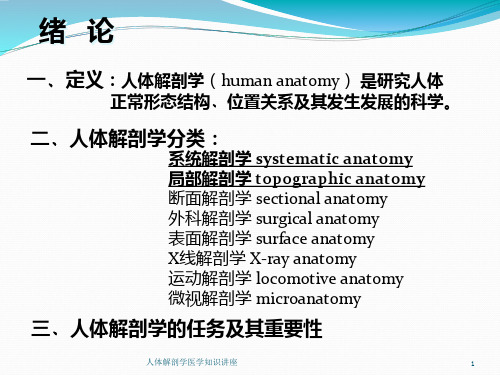
骨密质
内板 外板
骨松质-板障diploe
(2) periosteum骨膜
骨内膜 endosteum
骨膜 骨松质 骨密质
(3) bone marrow骨髓
骨髓
红骨髓red merrow 黄骨髓yellow merrow
骨膜
外板
终生有红骨髓的骨?
(4)骨的血管、淋巴管和神经 板障
内板
人体解剖学医学知识讲座
(三)Synosteosis 骨性结合 常由纤维连结或透明软骨骨化而成。
如骶椎椎骨之间,髂、耻、坐骨之间
人体解剖学医学知识讲座
13
二、Discontinuous joints
Articulation or synovial joints
(一)Basic structures关节的基本构造
1. Articular surface关节面: 关节头,关节窝 covered by articular cartilage 关节软骨
2. Articular capsule 关节囊:
外层--Fibrous membrane纤维膜
内层--Synovial membrane 滑膜
3. Articular cavity关节腔:
人体解剖学医学知识讲座
14
(二)Accessory structures 关节的辅助结构
1. Ligaments韧带(lig.): extra- and intracapsular ligaments 囊外(内)韧带
在四肢
近侧proximal和远侧distal
尺侧ulnar和桡侧radial
胫侧tibial和腓侧fibular
人体解剖学医学知识讲座
3
- 1、下载文档前请自行甄别文档内容的完整性,平台不提供额外的编辑、内容补充、找答案等附加服务。
- 2、"仅部分预览"的文档,不可在线预览部分如存在完整性等问题,可反馈申请退款(可完整预览的文档不适用该条件!)。
- 3、如文档侵犯您的权益,请联系客服反馈,我们会尽快为您处理(人工客服工作时间:9:00-18:30)。
MiHcruomscaonpiacnAantoamtoymiys the science Cytology Histology
of the normal structures of the hGurmosasnAbnoadtoym. y
3. History 历史
解剖学是一门历史悠久的科学,古希腊(公元前500-300年) 著名的哲学家希波克拉底 (Hippocrates) 和亚里斯多德 (Aristotle) 都进行过 动物实地解剖,第一部解剖学著作当推盖伦 (Galen,公元130-201年)的 《医经》; 文艺复兴时代,维扎里 (A. Vesalius, 1514-1564)完成了《人体 构造》的巨著,成为现代人体解剖学的奠基人。19世纪意大利学者高尔 基 (Camello Golgi,1843-1926) 和西班牙人卡哈 (Rom’on Y cajal,1852-1934) 建立了镀银浸染神经原纤维法,从而成为神经解剖学公认的两位创始人。 我国公元前300~200《黄帝内经》已有对人体解剖的记载。神医华陀深 通解剖,他甚至能够完成脑外科手术。
5. General structures of human body 人体构成
Innumerable cells 细胞
Tissues 组织 (epithelial, connective,muscular ,nervous)
Organs 器官
Systems 系统
The human body Formed by 9 systems: 九大系统
⑶ Clinical anatomy 临床解剖学
It incorporates the regional and systematic approaches and stresses clinical applications (e.g., surgical anatomy, X-ray anatomy, and sectional anatomy).
⑴ Systematic anatomy 系统解剖学
Systematic anatomy is to study the morphology according to the various functional systems of the body (e.g. , the cardiovascular system, digestive systems and so on).
10 regions 局部:
The human body can be divided into 10 regions:
head头部, neck颈部, back背部, thorax胸部, abdomen腹部, pelvis and perineum盆会阴部, left and right upper limbs左 右上肢, and left and right lower limbs左右下肢.
locomotor system 运动系统 digestive system 消化系统 respiratory system 呼吸系统 urinary system 泌尿系统 reproductive system 生殖系统 circulatory system (angelology) 脉管系统 sensory organs 感觉器 nervous system 神经系统 endocrine system 内分泌系统
considers features relatively visible without a microscope.
2. Subdivisions of natomy is classified into systematic anatomy 系统解剖学, Topographic anatomy 局部解剖学 and Clinical anatomy 临床解剖学 according to different methods and purpose of research.
人体解剖学的基础理论以及实践操作技能在医学科学的发展进 程中起着重要作用。随着科技的进步,近二十年来,人体解剖 学在断层解剖、组织工程学、神经科学等研究领域取得很大进 展,使这个古老的学科焕发出青春的光彩。 1994年美国科学家创造了 利用数字方法构造人体立体结构的数字解剖学或者称为虚拟解剖学,中 国解剖学会名誉理事长钟世镇院士亦主持863攻关项目 “数字化可视人 体”的研究。
塑化人体标本
加州大学开发的虚拟解剖系统
4. Importance of Learning Human Anatomy
In addition to the fundamental knowledge of the human body structures, human anatomy introduces the students to the language of medicine. It has been estimated that more than one-third of the medical terms are derived from anatomy. Therefore, human anatomy should be regarded as one of the basic subjects of the medical sciences. It would be very difficult for a student to master the medical language, if he or she didn’t learn human anatomy.
⑵ Topographic (regional) anatomy 局部解剖学
It is the study of the body (e.g., thorax and abdomen) dealing with structural relationships of the parts of the body in the region.
